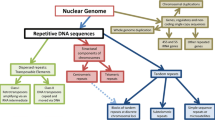Summary
Earlier, we reported that the ND1 mitochondrial gene of Podospora anserina is mosaic, containing at least three class I introns. We have now completed the sequence of the ND1 gene and have determined that it contains four class I introns of 1,820, 2,631, 2,256 and 2,597 by with the entire gene complex containing 10,505 bp, only 1,101 of which are exon sequences. Introns 1 and 3 appear to be related in that their open reading frames (ORFS) exhibit extensive amino acid sequence similarity and like the URFN sequence from Neurospora crassa have multiple sequence repetitions. Introns 2 and 4 are similar in that both appear to be mosaic introns. Where intron 2 has many short ORFS, intron 4 has two, 391 and 262 as respectively. The first ORF has some patch work sequence similarity with one of the intron 2 ORFs but the second ORF is strikingly similar to the single intron ORF in the ND1 gene of N. crassa. Just upstream of the sequences necessary to form the central core of the P. anserina intron 4 secondary structure, there is a 17 bp sequence which is an exact replica of the exon sequence abutting the 5′ flank of the 1,118 by N. crassa ND1 intron. Secondary structure analysis suggests that the 2,597 by intron 4 can fold as an entity but a similar structure can be constructed just from an 1,130 bp portion by utilizing the 17 bp element as an alternate splice site. Detailed structural analysis suggests that intron 4 (as well as the single ND1 intron from N. crassa) can utilize helical configurations which bring the downstream open reading frame into juxtaposition with the exon sequences.
Similar content being viewed by others
References
Banroques J, Perea J, Jacq C (1987) EMBO J 6:1085–1091
Bennetzen JL, Hall BD (1982) J Biol Chem 257:3026–3031
Brown TA, Davies RW, Ray JA, Waring RB, Scazzocchio C (1983) EMBO J 2:427–345
Burger G, Werner S (1985) J Mol Biol 186:231–242
Burger G, Werner S (1986) J Mol Biol 191:589–599
Burke JM, RajBhandary UL (1982) Cell 31:509–520
Burke JM, Belfort M, Cech TR, Davies RW, Schweyen RJ, Shub DA, Szostak JW, Tabak HF (1987) Nucleic Acids Res 15:7217–7221
Capaldi RA, Vanderkooi G (1972) Proc Natl Acad Sci USA 69:930–932
Cech TR, Zang AJ, Grabowski PJ (1981) Cell 27:487–496
Chomyn A, Mariottini P, Cleeter MWJ, Ragan CI, Matsuno-Yagi A, Hatefi Y, Doolittle RF, Attardi G (1985) Nature 314:592–597
Cummings DJ, MacNeil IA, Domenico J, Matsuura ET (1985) J Mol Biol 185:659–680
Cummings DJ, Domenico JM, Nelson J (1988) J Mol Evol (in press)
Davies RW, Waring RB, Ray JA, Brown TA, Scazzocchio C (1982) Nature 300:719–724
Dujon B, Colleaux L, Jacquier A, Michel F, Monteilhet C (1986) In: Wickner RB, Hinnebusch A, Lambowitz AM, Gunsalus IC, Hollaender A (eds) Extrachromosomal elements in eukaryotes. Plenum Press, New York, pp 5–27
Garriga G, Lambowitz AM (1986) Cell 46:669–680
Hensgens LAM, Bonen L, DeHaan J, VenderHorst G, Grivell LA (1983) Cell 32:379–389
Jamet-Vierny C, Begel 0, Belcour L (1984) Eur J Biochem 143:389–394
Kück U, Kappelhoff B, Esser K (1985) Curr Genet 10:59–67
Labouesse M, Herbert CJ, Dujardin G, Slonimski PP (1987) EMBO J 6:713–721
Lang BF (1984) EMBO J 3:2129–2136
Lazowska J, Jacq C, Slonimski PP (1980) Cell 22:333–348
Matsuura ET, Domenico JM, Cummings DJ (1986) Curr Genet 10:915–922
Maxam AM, Gilbert W (1977) Proc Natl Acad Sci USA 74:560–564
Michel F (1984) Curr Genet 8:307–317
Michel F, Cummings DJ (1985) Curr Genet 10:69–79
Michel F, Dujon B (1983) EMBO J 2:33–38
Michel F, Dujon B (1986) Cell 46:323
Michel F, Jacquier A, Dujon B (1982) Biochimie 64:867–881
Mota EM, Collins RA (1988) Nature 332:654–656
Morelli G, Macino G (1984) J Mol Biol 178:491–507
Nargang FE, Bell JB, Stohl LL, Lambowitz A (1984) Cell 38:441–453
Nelson MA, Macino G (1987) Mol Gen Genet 206:318–325
Rand KN, Gait MJ (1984) EMBO J 3:397–402
Seilhamer JJ, Olsen GJ, Cummings DJ (1984) J Biol Chem 259:5167–5172
Waring RB, Davies RW, Scazzocchio C, Brown TA (1982) Proc Natl Acad Sci USA 79:6332–6336
Author information
Authors and Affiliations
Rights and permissions
About this article
Cite this article
Cummings, D.J., Domenico, J.M. & Michele, F. DNA sequence and organization of the mitochondrial ND1 gene from Podospora anserina: analysis of alternate splice sites. Curr Genet 14, 253–264 (1988). https://doi.org/10.1007/BF00376746
Received:
Issue Date:
DOI: https://doi.org/10.1007/BF00376746




